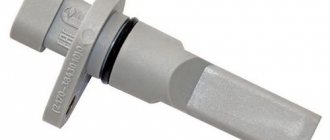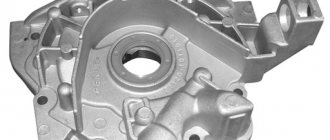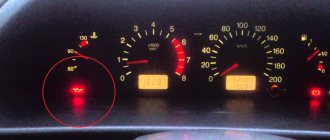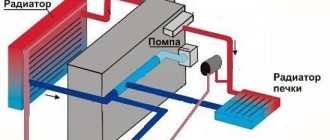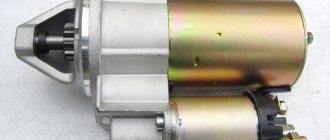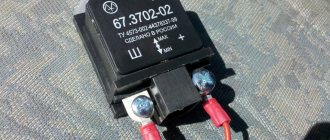Turn signals are designed to inform other road users about an upcoming maneuver. If they malfunction, the likelihood of an accident during maneuvering increases greatly. The most common cause of such a breakdown is a non-functioning VAZ 2107 turn relay. Traffic regulations prohibit operating a car with faulty light signals, so if such a malfunction is detected, it must be eliminated as soon as possible. This work can be performed by service station specialists.
However, replacing the turn relay is a fairly simple and not very labor-intensive operation, available even in the field. Therefore, knowledge about the design and method of replacing the VAZ 2107 turn signal relay will not be superfluous for owners of the “Seven”.
Where is the turn signal relay located on the VAZ-2107
Direction indicators, which are used in the design of absolutely any car, regardless of their model and brand, are designed to indicate the maneuver being performed. They allow other road users to immediately know that you intend to turn and are quite capable of preventing a traffic accident. The operation of the indicators, as well as their blinking during maneuvers, is ensured by the turn relay. In the 2107, it is an electronic device designed using semiconductors. In addition to them, the design of the device uses an electromagnet, which opens and connects contacts according to a certain pattern.
Purpose of the turn signal and hazard warning relays
Everyone knows that direction indicators and hazard warning lights blink during operation. This is necessary in order to attract the attention of other traffic participants. The flickering of lamps cannot be confused with any other signal supplied by lighting devices. A small device called a turn signal relay . In addition to the blinking of the turn signals, the relay provides another function - creating the necessary sound signal (click), which indicates that the turn signals are in operation.
The Zhiguli used two types of relays, which differ both in their design and in their operating principle.
- The first type is electromagnetic type relay, which is mounted in the engine compartment of the car. The basis for the operation of the electromagnetic thermal relay is a special nichrome string, which, when heated and cooled, closes and opens the direction indicator circuit. These types of relays were used on early models of the “classic” family: VAZ 2101-2102 and VAZ 2103.
- The second type of relay began to be used on VAZ 2106 and higher vehicles. It is an electronic circuit built on semiconductor circuit elements. In addition to semiconductors, the relay also includes an electromagnet, which performs the functions of closing and opening. The frequency of operation of the electromagnet (or flickering of lamps) is achieved using a “key”, or a special electronic circuit.
Location of the turn relay in VAZ-2107 cars
In order to easily and quickly fix any malfunctions of the VAZ-2107 turn relay, it is important to know where this device is located. Its location depends on the modification of a given car model:
- in cars with injection engines, the relay is located in the engine compartment, in a specially designed mounting block;
- in carburetor "sevens" the turn relay can be located directly in the cabin, behind the dashboard. In this case, to gain access to it, you will need to dismantle the torpedo, which will take much more time.
If the turn relay is located behind the dashboard, you can try to very carefully pry it up with a screwdriver and pull it towards you as far as possible.
Sometimes the length of the wires is quite enough to remove the part and install a new one.
FEATURES OF REPLACING THE BREAKER
For the “Seven” with a carburetor engine, there are some special features when changing the breaker.
In a VAZ 2107 with a carburetor engine, the difficulty of replacing the turn signal relay lies in the fact that it is located in the car interior behind the dashboard. To replace, the panel must be removed. This involves some inconvenience, but it can be done in your own garage.
Before you begin work on replacing the turn signal relay, you must remove the negative terminal from the car battery or disconnect the ground, if any.
The work is performed as follows:
- On the panel, to the right of the instrument panel, remove the daily mileage reset button.
- Remove the handles from the manual climate control levers in the cabin.
- On the right side of the panel, remove the plug covering the screw that secures the panel. Unscrew the screw.
- Disconnect the panel latches from the frame using a screwdriver. Pull the panel and remove it from the niche.
- Disconnect the wires leading to the panel.
- Unscrew the speedometer cable.
- Remove the econometric pipe, if equipped.
- Move the instrument panel to the side.
- Visually determine the placement of the relay. It is located to the right of the steering column.
- Disconnect the relay from the wires by pulling out the terminal block.
- Unscrew the nut securing the device.
- Remove the breaker.
- We connect the terminals with wires to the new relay and screw it on.
Further assembly and installation is carried out in the reverse order. After finishing, connect the battery and perform a test.
Having familiarized yourself with the theory of replacing the turn relay on a VAZ 2107, each owner of a “Seven” can independently solve this simple, important problem.
Thematic video:
Symptoms of a faulty turn relay
Turn signals, as well as the relay that ensures their correct operation, make it possible to minimize the risks of
road traffic accidents when performing any maneuvers. That is why it is necessary to constantly maintain them in good condition and promptly eliminate any malfunctions.
The failure of the turn relay may be indicated by the following symptoms, which can actually be identified even without experience and diagnostic work:
- The turn signals do not blink, but stay on continuously. This indicates a breakdown of the electromagnet, which is stuck in one of two positions. Most likely, the relay may need to be replaced;
- The turn signal lamps flicker too quickly or, on the contrary, too slowly. This problem may be caused by incorrectly selected power of the light sources, however, it does not hurt to check the functionality of the relay;
- The turn signals don't work at all. It is quite possible that the cause of the breakdown is a burnt-out light bulb, a broken electrical contact, or a failed fuse. But if all these parts work normally, the problem lies in the turn relay.
Finding out that the device is not working is not difficult at all. If you do not hear characteristic clicks when you turn on the turn signals, then most likely the relay has failed and requires urgent replacement.
Self-diagnosis of car lighting devices
Connection diagram for generator 2107 to 2106
There are several situations in which it can be determined that the optics need diagnostics:
- The turns do not flash, but light up. Such a malfunction indicates the failure of the relay, in particular, we are talking about its electromagnetic component. The electromagnet itself could close in one of the positions, as a result of which it cannot return to its initial state.
- The turning lights flash very quickly or very slowly. In this case, the problem may lie not only in the relay. In some cases, this type of malfunction occurs when the driver uses inappropriate lighting sources. So when purchasing new light bulbs, you need to make sure that they correspond to the rating set by the car manufacturer.
- The optics don't work at all. That is, the turning light bulbs do not flicker, and the corresponding indicators on the dashboard also do not light up. In addition, there are no characteristic clicks that appear when turning on the turning lights. With such symptoms, there can be many reasons for the problem; we will tell you more about their diagnosis below (the author of the video is the Steel Horse channel).
As for diagnostics, it is performed in several stages:
- First of all, you need to make sure that all sensors and indicators on the device are working. If they do not function, then it is necessary to diagnose the safety devices.
- If all devices are operating in normal mode, then you next need to turn on the light alarm button and diagnose all light sources in the headlights. That is, check the front, rear, and side (if any) lights.
- If the alarm does not function when activated, you need to check the functionality of the relay, and also check the power supply at the terminals. To do this, remove the relay from its mounting location, and then, using a test light, connect one of its contacts to the installation site (to the positive), and the other to the car body or battery. There is no need to turn on the ignition. If there is no power, then most likely the reason lies in a failed safety device, a broken hazard warning button, or a damaged electrical circuit. Also, the essence of the problem may lie in poor contact in the connecting plugs.
- If there is a plus on the contacts, then try shorting the two relay terminals using copper wiring. If all electrical circuits, as well as the connection plugs, are working properly, then all turn signals should light up. In this case, the fault must be looked for in the relay.
- If the lights do not light up after the steps you have performed, then most likely the cause of the malfunction lies in the emergency light control button. However, in practice this happens quite rarely; there is often a short circuit in the circuit. By the way, it is a short circuit that can lead to a breakdown of the relay, therefore, before replacing the failed element, you need to eliminate the short circuit.
- If the emergency signal is functioning, this indicates that the safety devices and relays are working; accordingly, you need to start diagnosing the button itself. First of all, you need to diagnose the positive terminal, as in the case of checking the relay, while the ignition, as well as the hazard warning button, must be activated. If the diagnostics showed that there is no plus, this indicates that the button itself needs to be checked in more detail. Remove it from its seat and check the connection circuit. If there is no power, then you need to look for a break in the wiring from the tidy to the button itself. If there is power, then it will be necessary to short-circuit the terminals at the installation site, the ignition does not turn off, after which the direction indicators must be activated (on either side). When the lighting sources are turned on, the control button must be replaced, but if there is no power, then you need to check the power in the emergency relay. If there is no power, the problem most likely lies in a break in the connecting electrical circuit from the control key to the block with safety devices.
How to remove the turn signal relay
As we mentioned above, on cars with a carburetor engine, disassembling the dashboard may be required to remove the turn relay.
This is a rather lengthy procedure that requires appropriate experience. On modifications of the VAZ-2107 with more modern injection engines, removing the turn signal relay is much easier:
- open the hood and get to the mounting block;
- we find the relay;
- we pry up the device and pull it upward;
- disconnect the wires connecting the relay to the vehicle's on-board network.
After this, you can quickly install the new part and securely fix it in the mounting block.
Replacing the windshield wiper relay
The windshield wiper relay (PC-514) is designed to ensure intermittent operation.
It is installed under the instrument panel on the driver's side and attached to the body with two screws.
General view of the relay with the block.
Using a screwdriver, remove the left side trim.
For its subsequent installation, two new fastening buttons will be required.
Using a Phillips screwdriver, unscrew the two self-tapping screws securing the relay.
The relay connector is located in the instrument panel, next to the headlight leveling control.
You can get to it from below the dashboard. It is important not to make a mistake with the connecting block.
Relay block with four terminals (instrument panel removed for clarity)
Technical data to check:
Relay winding resistance, Ohm
Breaker winding resistance, Ohm
Number of purifier activations per minute
*After turning on the cleaner, the brushes can make up to four continuous double strokes until the bimetallic strip reaches operating temperature
Turn signals are perhaps a very important part of any vehicle. Carrying out maneuvers on the road becomes quite a dangerous task if the turn signals do not work. The VAZ 2107 turn signal and hazard warning relay is responsible for the correct operation of the direction indicators. This device is used on all cars of the classic family. Let's consider why a turn signal relay is needed, how is a relay malfunction determined and how is it replaced?
Turning relay for VAZ-2107
Every car has turn signals, the main purpose of which is to inform other road users that a maneuver is being performed or intended to be performed. If your car's turn signals are not working, it greatly increases the likelihood of an accident when maneuvering or changing lanes. Why don't turns work on the VAZ 2107? The causes of such a breakdown in frequent cases are nothing more than the turn relay. Today we will pay attention to the question of how to replace this relay on the “seven”.
Location in the car
There are two types of location of turn signals in the classic VAZ family of cars, depending on the modification:
Let's start disassembling
- Early modification models
To get to the relay, you need to remove the plug by unscrewing the bolt on the dashboard.
We pull the entire panel towards us, move the sensor panel a little to the side so that we can get to the relay.
- The contacts approach the relay from below.
- Disconnect the contacts.
- We remove the old device and install the new one.
- We put the dashboard back, sliding it into the side grooves.
- Screw in the bolt.
We check the turn signals for flickering and characteristic clicks. The frequency of contact closure should be approximately 1 time per second.
The technology is very simple. The main difficulty here is accessibility to the relay. The space under the panel of these models is small, getting there is problematic.
- Later models
- Remove the screws from the steering column switch housing. We remove the casing elements.
- Unscrew the mounting bolt.
- We take out the devices on the electrical wiring inside the cabin.
- We replace the old relay with a new one.
- Screw it back. We put the covers in place.
Important: it is recommended to replace the relay itself or the mounting block as an assembly, given that the wiring often burns out and restoring the contacts is quite problematic.
When replacing any of the above relays, special attention should be paid to contact insulation. Insulation is performed using hollow mass braiding. To tie the wires, use a special strip clamp.
Transition from an electromagnetic-thermal relay to an electronic one.
This “barrel” is located under the dashboard of a car. This is an electromagnetic thermal relay. Due to short-term operation (1-2 months), it is recommended to replace it with an electronic one. After this time, it begins to burn or shorts out.
The following are the steps to replace it:
- disconnect the contact terminals;
- We mark each wire with a marker, or use paint to highlight it in different colors;
- contact No. 1 of the electronic relay is connected to the wire with the x sign;
- Contact No. 2 of the electronic relay is connected to the wire marked L;
- contact No. 3 of the electronic relay is connected to the wire marked P;
- Contact No. 4 is ground, we connect it to a separate wire.
All this work must be carried out when using heat shrink.
The replacement of incandescent lamps with LEDs in direction indicators is gaining great popularity due to the fact that incandescent lamps are much inferior to LED lamps in terms of service life and light output.
Turn relay VAZ 2107
Turn signals are designed to inform other road users about an upcoming maneuver. If they malfunction, the likelihood of an accident during maneuvering increases greatly. The most common cause of such a breakdown is a non-functioning VAZ 2107 turn relay. Traffic regulations prohibit operating a car with faulty light signals, so if such a malfunction is detected, it must be eliminated as soon as possible. This work can be performed by service station specialists.
However, replacing the turn relay is a fairly simple and not very labor-intensive operation, available even in the field. Therefore, knowledge about the design and method of replacing the VAZ 2107 turn signal relay will not be superfluous for owners of the “Seven”.
Malfunctions of turn signals VAZ 2107
The main symptom of a malfunction is non-functioning direction indicators. However, the reason may not be only the relay. There are several possible breakdowns:
- The turn signal lamps are constantly on and do not blink. This indicates a malfunction of the electromagnetic part of the VAZ 2107 turn signal relay - the contacts are stuck in the closed position and do not open. This could be either a burnt-out contact of the electromagnetic relay or a failure of the electronic circuit of the turn relay. Regardless of the specific reason, there is only one way out - replacing the VAZ 2107 turn signal relay.
- Lights flash too slowly or quickly. The reason may be either in the electronic part of the turn relay or in the discrepancy between the current consumption of the lamps and the nominal one. If one of the lamps has burned out or lamps that consume less current are installed, the turns will flash more often than necessary. The same phenomenon occurs if the wire going to one of the lamps is broken, or the lamp socket or base is oxidized. A similar phenomenon occurs when installing LED lamps instead of incandescent lamps. When installing more powerful lamps, the blinking frequency decreases. If all the lamps are in working order and the malfunction did not appear after replacing the lamps, the reason lies precisely in the turn relay or poor contacts in the lamp power circuit.
- The direction indicator lamps do not light up. The cause of the malfunction may be a broken turn switch, a burnt-out (faulty) turn relay, an open circuit, or a blown fuse. It is better to start checking from the last one
Purpose of the device
Initially, it should be noted that turns operate differently than other lights on a car. They operate in intermittent mode, which is ensured by a product such as the VAZ-2107 turn relay (breaker).
It should also be noted that in addition to intermittent operation, the turn relays emit audible signals in the form of clicks, which help the driver. By these clicks, the driver understands that the device is currently functioning.
In addition to the fact that the breaker is responsible for the functioning of the light alarm necessary for maneuvers, it also allows them to work in emergency mode. The VAZ-2107 uses an electronic relay, the blinking frequency of which lamps depends on the settings of the electronic circuit. Above is a photo of a modern electronic turn signal relay, which is used on VAZ-2107 cars.
Diagnosis of turn signal faults
If one day the turn signals stop functioning, this indicates that it is time to diagnose the car. To do this, there is no need to go to a service station, but you can do everything at home. The following signs indicate that the mechanism has stopped functioning:
- When turned on, the turn signals light up, but they do not flicker. This type of failure is directly related to the failure of the relay. To correct the problem, you need to replace the breaker.
- Accelerated or slow flickering of turn signals. Accelerated flickering indicates that the filament of one of the lamps has burned out. Slow flickering indicates that at least one lamp of higher power than recommended is connected to the circuit. With the advent of modern LED lamps, many motorists are eager to install them on their cars. When installing LED lamps in turn signals, they flicker too quickly, this is due to their low power consumption.
- The devices do not function at all. The reason may be a malfunction of the relay, fuse, steering column switch or hazard warning light button. The connection diagram is designed so that the power for the turn signals passes through the emergency light button. If the button is faulty, then the turns will not function.

